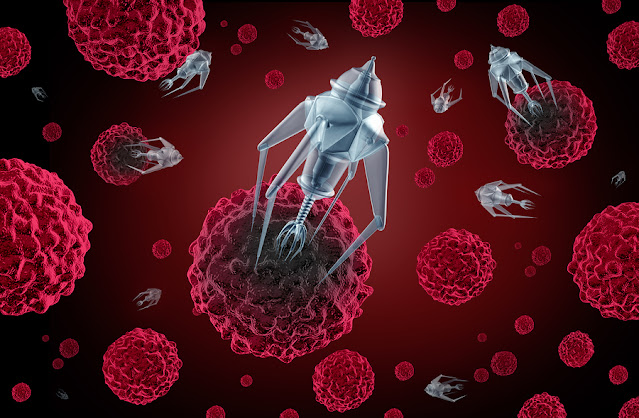Nanotechnology Drug Delivery: Unlocking New Possibilities for Treating Disease
 |
| Nanotechnology Drug Delivery |
Nanotechnology
is the manipulation of matter on an atomic, molecular and supramolecular scale.
When applied to medicine, nanotechnology enables scientists to build tiny
structures and devices that travel through the body to deliver drugs, target
cancer and other diseases, and overcome biological barriers that limit
conventional drug delivery. Researchers are developing nanoparticles,
nanovesicles, nanotubes and other structures to revolutionize how medications
are administered, absorbed and distributed in the human body. This emerging
field of nanomedicine holds tremendous potential for improving drug efficacy
and reducing harmful side effects.
Enhanced Targeting through Nanotechnology Drug Delivery
One key application of Nanotechnology
Drug Delivery in medicine is using nanoparticles as carriers
to transport drugs through the body. Conventional drugs disperse throughout the
body's tissues and fluids, meaning only a small fraction reaches the intended
site of action. Nanoparticle carriers allow drugs to be packaged and guided
more precisely to diseased cells and tissues. Different types of nanoparticles
are being designed and tested, including lipid-based carriers like liposomes,
polymer-based carriers like dendrimers, gold nanoparticles and others. By
attaching targeting molecules like antibodies to their surface, these
nanoparticle carriers can recognize and bind specifically to receptors
overexpressed on disease cells. This enhanced targeting ability improves drug
accumulation at the site of disease while avoiding healthy tissues.
Overcoming Biological Barriers for Improved Nanotechnology Drug Delivery
Biological barriers in the body, such as the blood-brain barrier, limit the
effectiveness of many drugs that cannot cross or diffuse through these barriers
to reach their intracellular targets. However, nanocarriers can potentially
overcome these limitations. Medications encapsulated in or bound to
nanoparticles can slip past biological barriers more readily due to their smaller
size. Certain nanoparticles are engineered to actively transport drugs across
barriers using molecular shuttle mechanisms. For example,
transferrin-conjugated nanoparticles utilize transferrin receptors to traverse
the blood-brain barrier and deliver drugs to the brain. These transport
capabilities of nanoparticles open up new possibilities for developing
successful treatments against previously untreatable conditions behind
biological barriers.
Controlled and Sustained Drug Release from Nanocarriers
In addition to enhanced targeting, nanoparticles provide benefits for
controlled drug release at the target site over an extended time period.
Conventional drugs often need frequent readministration to maintain therapeutic
concentrations. However, by encapsulating or loading medications inside
nanocarriers, their release rate can be tailored for controlled or sustained
delivery. Different fabrication techniques allow drugs to be released
continuously through diffusion, degradation of the nanoparticle matrix, or in
response to external triggers like changes in pH or temperature. This
controlled release avoids spikes and troughs in drug levels for safer and more
effective long-term therapy with fewer side effects from repeated dosing.
Liposomes, dendrimers, polymeric nanoparticles and other advanced designs are
being studied for their ability to precisely program drug release kinetics.
Improving Anticancer Therapies Using Nanotechnology Approaches
Oncology is one area at the forefront of utilizing nanomedicine techniques for
improved diagnostics and treatments. Nanoparticle-mediated drug delivery holds
promise for overcoming drug resistance in cancers by transporting higher drug
concentrations directly into tumors. Nanocarriers allow coupling of multiple
anti-cancer agents for combination therapies in a single nanoplatform.
Therapeutics can even be released sequentially for synergistic treatment
regimens tailored against particular cancers. Molecularly-targeted
nanoparticles developed with ligands for cancer biomarkers optimize drug
accumulation within tumors while sparing healthy tissues. These include
HER2-targeted liposomes for breast cancer and folate receptor-targeted
nanoparticles for ovarian cancer. The multifunctional abilities of
nanoparticles also support imaging-guided chemotherapy by combining anti-cancer
drugs with contrast agents. Overall, nanotechnology is radically transforming
cancer management approaches.
Regulatory Considerations and Future Outlook
Despite promising advancements, translating nanomedicine from the laboratory to
clinical practice involves overcoming several regulatory and commercialization
challenges. Prior to human studies, thorough characterization and safety
testing of nanomaterials is required to avoid potential toxicities. The
long-term effects of nanoparticles in the body after clearance also needs
investigation. Standardizing large-scale manufacturing while maintaining
well-controlled particle properties presents another hurdle. Nevertheless, with
ongoing scientific progress and enhanced collaboration between researchers,
industry partners and regulatory agencies, many nanomedicine platforms are
progressing through clinical trials. As the safety and efficacy of early
generations are validated, new and more powerful applications integrating
diagnosis, treatment and monitoring will surely emerge. With its ability to
address so many limitations of conventional medicine, nanotechnology
undoubtedly holds tremendous hope for revolutionizing healthcare worldwide in
the coming decades.
nanotechnology introduces exciting possibilities for improving drug
formulations and transforming disease management. By enabling targeted,
controlled and sustained delivery, nanoparticles overcome biological barriers
that block conventional therapeutics from reaching their sites of action.
Diverse applications are under development across multiple therapeutic areas,
including enhanced anticancer treatments. While regulatory and manufacturing
challenges remain, ongoing research advances are bringing this promising new
field of medicine steadily closer to widespread clinical adoption and
implementation of its many benefits. Nanotechnology will likely play a central
role in shaping healthcare solutions of tomorrow.
Get More Insights—Access the Report in the Language that Resonates with You.
About Author:
Ravina Pandya, Content Writer, has a strong foothold in the market research
industry. She specializes in writing well-researched articles from different
industries, including food and beverages, information and technology,
healthcare, chemical and materials, etc. (https://www.linkedin.com/in/ravina-pandya-1a3984191)


Comments
Post a Comment